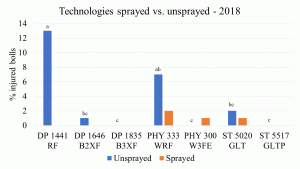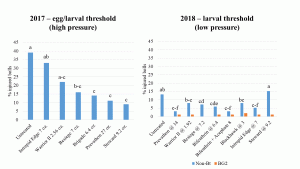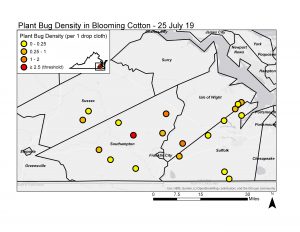The much needed rain earlier this week also heralded the start of the moth flight in southeastern VA. Both eggs and adult moths are being picked up by scouting teams. So far, only a handful of fields are over recommended thresholds. I recommend scouting 2-gene cotton (Bollgard II, Widestrike, Twinlink) for eggs and applying Prevathon or Besiege when you find 25 or more per 100 terminals and/or leaves. If you planted 3-gene cotton, you are likely protected. We have measured very little benefit to spraying Widestrike 3, Bollgard III, and Twinlink Plus varieties for bollworm. In these varieties, finding 3 or more live second-stage larvae in one trip (or two worms in two consecutive trips, or one worm in three consecutive trips) triggers an application.
Other insecticides can control bollworm in cotton, but timing is critical. If you are using a pyrethroid, for example, target small worms. No product will clean up a problem field once worms are inside bolls.
Our team, lead by PhD student Seth Dorman, ANR Agent Josh Holland, and Dr. Sean Malone are scouting fields this week for lygus. Few problems fields were detected in southern counties today. However, fields were observed over recommended thresholds. At this point, many people have sprayed. Some may need to spray again and some may not. The only way to know is to scout.
Northern counties will be scouted this Friday and I will update the blog with our findings.
As always, you can reach out to me with your questions and concerns.



